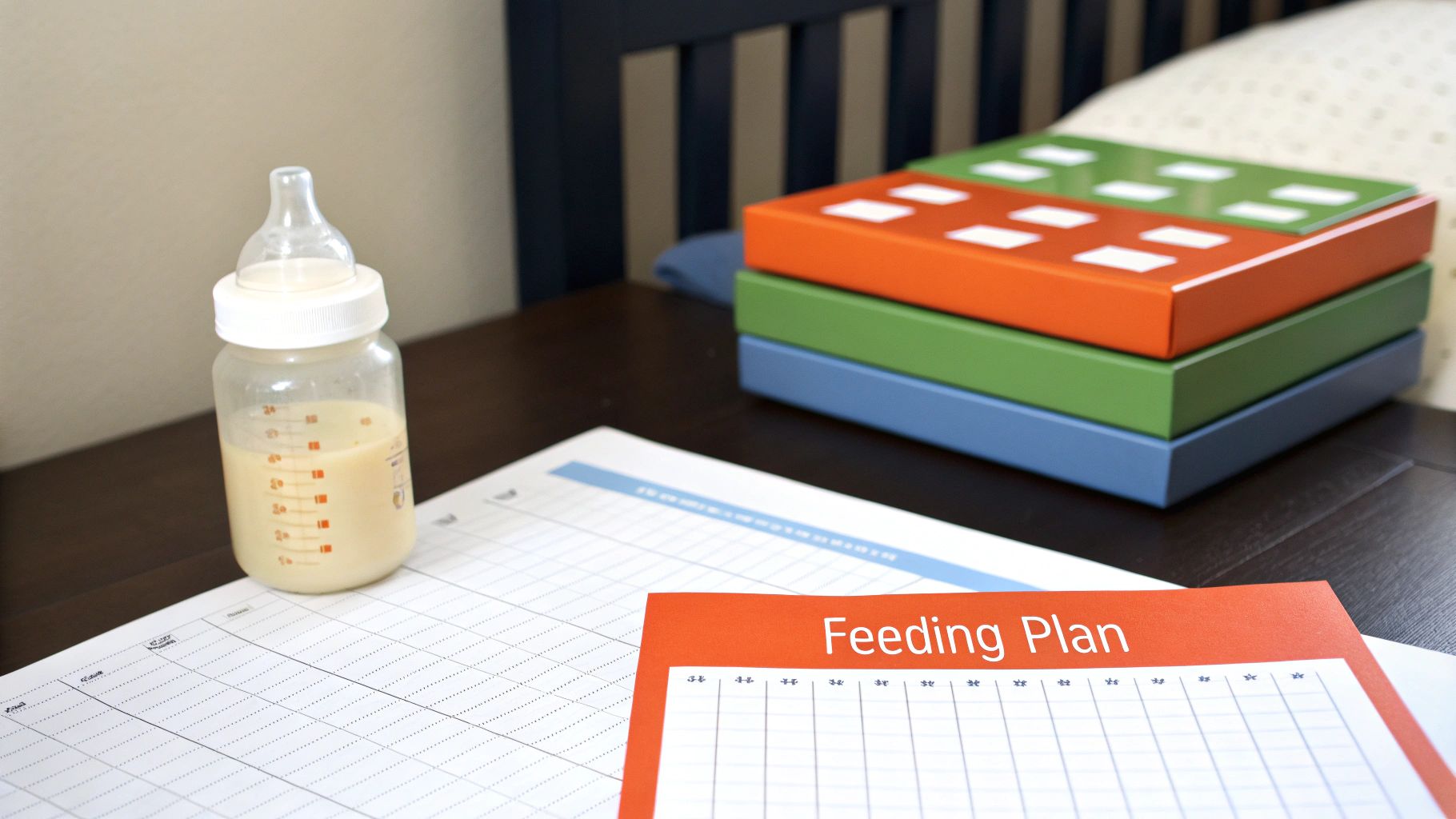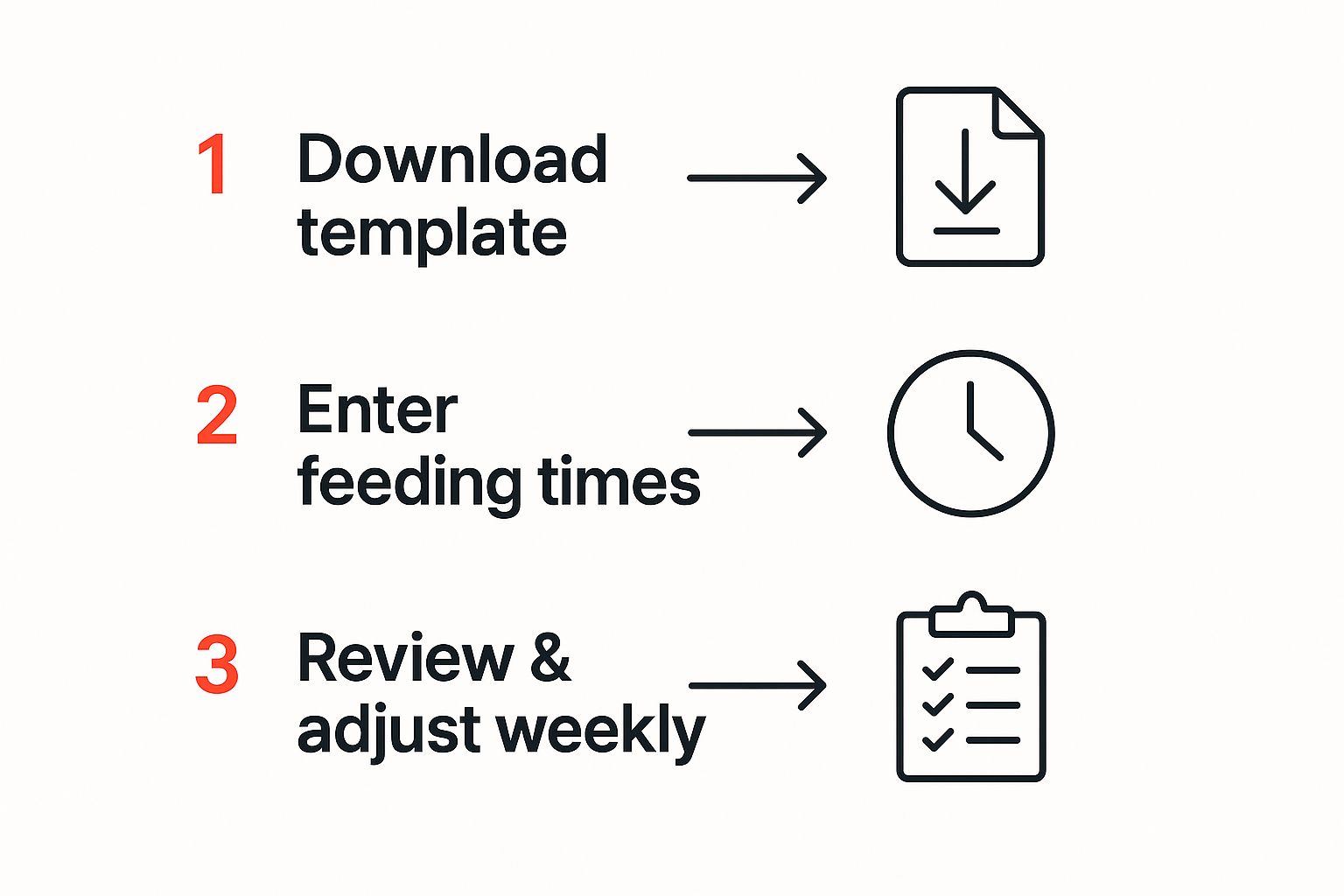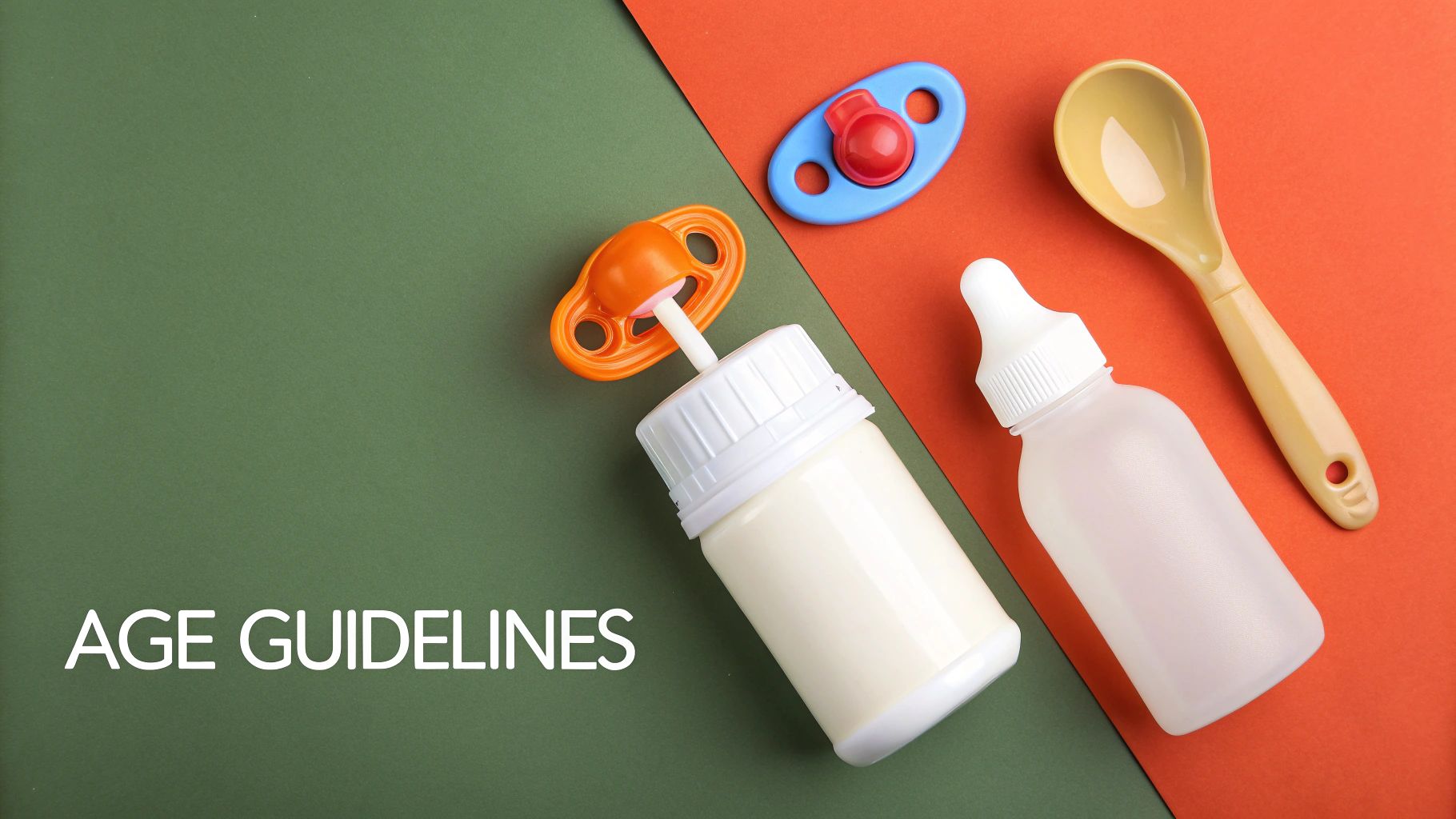
Your Guide to Creating a Baby Feeding Schedule Template
Bringing your baby home is a time of incredible joy, but it also comes with countless questions. Among the snuggles and new baby smells, one concern often stands out: "Is my baby eating enough?" This is a universal worry for new parents, and a well-designed baby feeding schedule template can be an invaluable tool for finding peace of mind.
Think of this template not as a strict set of rules, but as a helpful logbook for you and your baby. It's a simple, effective method for tracking feeding times, amounts, and diaper output. This information allows you to recognize your baby's unique patterns, removing much of the guesswork from those early, sleep-deprived days and empowering you to provide the best possible care.
Why a Feeding Template Is a New Parent's Best Friend

The newborn phase is a beautiful whirlwind. A feeding template can provide a sense of stability, helping you tune into your baby's specific hunger cues rather than just guessing. By logging each feeding, you aren't enforcing a rigid routine; you are gathering valuable information that supports confident, informed, and responsive care.
Gaining Clarity in the Fog of Newborn Life
In those first few weeks, feeding your baby is a constant, round-the-clock activity. With their tiny stomachs, newborns typically need to eat 8 to 12 times in a 24-hour period. That’s a significant amount of information to keep track of, especially when you're navigating sleep deprivation.
Instead of trying to recall the last feeding time at 3 AM, a quick glance at your log provides the answer. This tangible record is also incredibly beneficial during pediatrician appointments, offering your doctor a clear, accurate picture of your baby's intake and output, which are key indicators of their health.
Tracking your baby’s feedings is a small effort with significant benefits, especially as you navigate the challenges of early parenthood.
Key Benefits of Using a Feeding Template
Here is a summary of the main advantages of tracking your baby's feedings with a template.
| Benefit | Why It Matters for New Parents |
|---|---|
| Reduces Anxiety | Replaces worry and guesswork with concrete data, offering peace of mind. |
| Monitors Health | Provides a clear record of intake and diaper output for pediatrician visits. |
| Identifies Patterns | Helps you spot your baby's natural hunger cues and developing routines. |
| Improves Communication | Creates a single source of truth for you, your partner, and other caregivers. |
Ultimately, a simple log empowers you to care for your baby with more confidence and less stress.
A feeding log isn't about control; it's about understanding. It empowers you to see the emerging patterns in your baby's day, helping you anticipate their needs with less stress and more confidence.
At its core, a baby feeding schedule template provides peace of mind by helping you learn what's normal for your baby. It’s one of the most practical tools you can have in your parenting toolkit. For more helpful tips, check out our guide on essential items for first-time parents. This small step can make a huge difference in your journey.
Choosing and Customizing the Right Template

The most effective baby feeding schedule is the one you’ll actually use. Whether it's a dedicated app, a printable PDF on the fridge, or a simple notebook on the counter, what matters most is choosing a format that fits seamlessly into your life.
Regardless of the style you choose, certain key details are essential for any effective feeding log. These form the foundation of your tracking system.
The Absolute Must-Haves:
- Time and Date: This is your anchor, showing you exactly how often your baby is eating.
- Feeding Details: Log the duration for each breast or the amount in ounces for formula.
- Diaper Count: A simple tally of wet and dirty diapers is one of the most important indicators of your baby's health and hydration.
- A "Notes" Section: This space is invaluable. Use it to record anything out of the ordinary—unusual fussiness, significant spit-up, or even happy little milestones.
Making the Template Your Own
This is where you transform a generic chart into a powerful parenting tool. Customizing your template ensures you're tracking what is truly relevant to your baby and your family, providing a clearer picture of their well-being.
Consider tracking information beyond the feeding itself. If you are also pumping, add a column for that. If your baby needs medication at certain times, create a spot to check it off. Many parents find that tracking sleep cycles alongside feedings can be a game-changer, revealing how one directly impacts the other. For more ideas on helpful gear, you can browse our list of essential baby items to see what else might support your routine.
A personalized template helps you connect the dots between feeding, sleep, and your baby’s overall mood. It stops being just a chart and starts telling the story of your baby's unique patterns.
By adding these personal touches, you’re creating a resource that goes far beyond tracking milk. It becomes a central hub for understanding your baby's day, making it an invaluable tool for you, your partner, and your pediatrician.
Navigating Newborn Feeding Schedules (0-3 Months)
The first three months with a newborn are an intense and beautiful period of round-the-clock care. During this phase, a "schedule" is not about rigid times but about being responsive. Your primary role is to feed on cue, watching for your baby’s hunger signals rather than adhering to a strict timetable.
Newborns have tiny stomachs and grow at an incredible rate, so they need to eat frequently—often 8 to 12 times in a 24-hour period. This can feel relentless, but it is essential for their development.
Whether you're breastfeeding or formula-feeding, your baby sets the pace. Some days may fall into a predictable rhythm, while others might introduce you to cluster feeding, where your baby wants to nurse almost continuously for several hours. This is completely normal behavior, especially during growth spurts.
Understanding Your Newborn's Rhythm
For the first few months, focus on learning your baby's early hunger cues instead of watching the clock. These are the subtle signals they give before they become upset and start crying.
Look for signs like:
- Bringing their tiny fists to their mouth
- Rooting—turning their head and opening their mouth as if looking for the nipple
- Making soft sucking or lip-smacking sounds
Responding to these early cues not only builds trust but also makes feeding time much calmer for everyone. A baby feeding schedule template at this stage is a tool for observation, not enforcement. It is a simple way to begin recognizing the natural patterns that emerge over time.
The best tool you have in these early months isn't a clock—it's your ability to listen to your baby. Staying flexible and responsive will make life less stressful for both of you and helps build a great foundation for healthy eating habits down the road.
Even when feeding on demand, tracking those feeds is incredibly helpful. This simple flow illustrates how a template can become your best friend.

The key takeaway here is that tracking is a dynamic process. It's a cycle of observing, logging, and adjusting as your baby's needs change from one week to the next.
To provide a better understanding of what to expect, here is a quick look at some common feeding patterns for newborns.
Sample Newborn Feeding Patterns (0-3 Months)
| Age | Typical Frequency (per 24 hrs) | Average Amount per Feeding (Formula) | Average Duration per Feeding (Breastfeeding) |
|---|---|---|---|
| 0-1 Month | 8-12 times | 2-4 ounces | 20-45 minutes |
| 1-2 Months | 8-10 times | 4-5 ounces | 20-30 minutes |
| 2-3 Months | 6-8 times | 4-6 ounces | 15-25 minutes |
Keep in mind these are just averages. Your baby is unique, and their appetite will naturally vary from day to day.
While frequent feedings are standard, it's also true that maintaining feeding goals can be challenging. For example, data on U.S. breastfeeding practices shows that only about 24.4% of infants under six months were exclusively breastfed in a recent survey, falling short of the WHO's 50% target. Using a flexible baby feeding schedule template can be a fantastic support system to help you reach your own goals during this demanding but rewarding stage.
Your Baby's Schedule from 4 to 12 Months: Keeping Up with Their Growth

Just as you master the newborn feeding rhythm, everything changes. From four to twelve months, babies experience incredible growth spurts and achieve major developmental milestones. Your feeding schedule template must evolve to keep pace with these changes.
During this period, you’ll likely transition from constant, on-demand feedings to a more predictable (but still flexible) daily routine. You may notice your baby can go longer between meals. A three-month-old who needed milk every couple of hours might now, at six months old, be content with feedings every 3 to 4 hours. Many babies also start dropping night feeds around this age, a welcome development for sleep-deprived parents.
Bringing in the Solids
Around the six-month mark, the exciting milestone of introducing solid foods arrives. This is a significant step in your baby's development, and your template is the perfect tool for tracking this new experience.
Remember, for the first year, breast milk or formula remains their primary source of nutrition. Solids are about exploration—introducing new tastes, textures, and supplemental nutrients. This aligns with health expert recommendations for exclusive breastfeeding for the first six months. It’s worth noting that between 2015 and 2020, only about 44% of infants globally were exclusively breastfed for that duration. You can read more about these global infant feeding statistics on paho.org.
To manage this new adventure, consider adding a few new columns to your template:
- New Foods Tried: Be specific. Write down "mashed banana" or "oatmeal cereal."
- Baby's Reaction: Note how they responded. Did they enjoy it or make a funny face?
- Any Allergic Reactions: Keep a close eye for anything unusual, such as a rash, increased fussiness, or an upset stomach.
Expert Tip: Tracking solids is more than just a food diary. It’s about discovering what your baby loves and, just as importantly, spotting potential sensitivities early on. Think of these notes as a vital health record for your pediatrician.
By adapting your baby feeding schedule template, you’ll feel more confident as you navigate the transition from an all-liquid diet to a colorful mix of milk and solid foods. It's all about ensuring your little one gets exactly what they need to thrive.
Using Your Template to Solve Feeding Challenges
Even with the most organized plan, feeding challenges are a normal part of the new parent journey. You might face a sudden feeding strike, deal with frustrating reflux, or worry about slow weight gain. These situations can feel overwhelming.
This is precisely when your baby feeding schedule template transforms from a simple log into a powerful problem-solving tool. It helps you connect the dots and understand what's happening when things feel confusing.
By reviewing the detailed data you’ve collected, you can begin to see underlying patterns. You might spot the trigger for evening fussiness or a connection between a poor feed and a specific food. Vague worries can be transformed into specific, actionable observations.
Pinpointing Specific Problems
Imagine your baby becomes incredibly fussy about an hour after every feeding. With your template, you have a clear, documented pattern to present to your pediatrician. This is far more effective than trying to recall details from memory during a rushed appointment.
A detailed feeding log empowers you to have more productive conversations with healthcare providers. It provides the "what, when, and how often" that helps them offer targeted, effective advice much faster.
If you're navigating issues like reflux or frequent spit-up, the right physical support can also make a world of difference. Sometimes, simply positioning your baby more comfortably with a good pillow during and after feeds can significantly aid their digestion. You can explore different multifunction nursing pillows to find a design that offers optimal support for you both.
Ultimately, your records help you become a confident advocate for your baby. Instead of feeling uncertain, you can enter appointments with clear, organized information, making troubleshooting less stressful and leading to solutions more quickly.
Answering Your Top Feeding Schedule Questions
As you settle into a routine with your new baby, questions are bound to arise. This is completely normal. Here are answers to some of the most common concerns parents have when using a feeding schedule template.
Should I Wake My Newborn to Eat?
In the first few weeks, the answer is almost always yes. Newborns have very small stomachs and need to eat frequently to regain their birth weight and support healthy growth.
Most pediatricians recommend waking your baby if they sleep for more than 3-4 hours at a time during this initial period. Once your doctor confirms that your baby's weight gain is on track, you can typically let them sleep for longer stretches at night.
How Do I Know if My Baby Is Getting Enough Milk?
Your feeding log is a fantastic tool for answering this question. While consistent weight gain, monitored by your doctor, is the best overall indicator, you can look to their diapers for daily reassurance.
After the first week, you should expect to see at least 6-8 wet diapers every 24 hours. Tracking this in your template provides a concrete record that confirms they are well-hydrated and getting sufficient milk.
A feeding schedule template isn't about ignoring your instincts—it's about sharpening them. The goal is to see your baby's patterns so you can better understand their unique hunger cues, not to chain them to the clock.
When Can I Stop Using a Feeding Template?
There is no specific date to stop using a log. Most parents find it most valuable during the first 3-6 months, when routines are still forming and developmental changes are rapid.
You can stop tracking whenever you feel confident in your ability to understand your baby’s cues without needing to write everything down. However, some parents find it helpful to use a simplified version again during major transitions, such as starting solids or experiencing a sleep regression, to help keep things on track.
At MiniPrecious, we know parenting is a journey filled with learning and love. We're here to help with products that make your life just a little bit easier. Take a look at our collections today at https://miniprecious.com.

